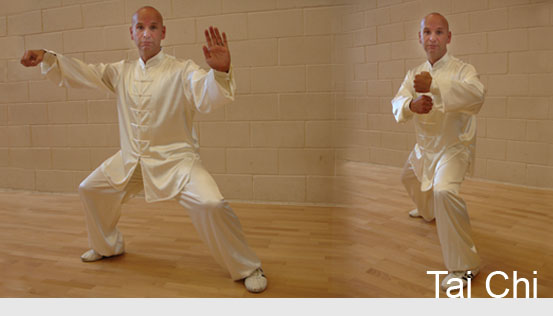Origins: Tai Chi belongs to the internal school of martial arts and has enjoyed centuries of popularity throughout China.
The story of Tai Chi begins with its founder Chang San-Feng, a Taoist who is reported as having lived either during the Sung (960-1279) or the Yuan dynasty (1271-1368).
According to legend, one day while strolling through the forests surrounding the Wu Tang Mountains in China's Hubei Province, Master Chang witnessed a snake engaged in combat with a crane. Master Chang was impressed with the skilful way the snake was able to dodge and counterattack the larger, more powerful crane. However, there is very little documentary evidence relating to the exact origins and a reliable historical account is not possible. Today Tai Chi is seen as a practical technique for health and healing, relaxation and martial arts and as such is spreading out of China to other parts of the world.

Principles:
Tai Chi consists of a series of continuous, smooth and graceful yet purposeful movements linked together to produce a standard form or routine. The principles of the Tai Chi forms are to move in a relaxed manner using concentration and breathing to direct each posture. In this way, we can improve overall strength and agility in the legs, relaxation in the upper body and suppleness in the waist. The waist is a very important feature of Tai Chi since it acts as a pivot for the body, developing fluidity, balance and power.
Movements are rounded to maintain stability and to keep the joints open and muscles relaxed. This structure facilitates the passage of Chi or vital energy throughout the body. Tai Chi Chuan means "Supreme Ultimate Hand Fighting". Tai Chi as a martial art has a simple yet essential theory; the use of softness (yin) to overcome hardness (yang) and conversely, the use of hardness to overcome softness. Therefore, attacks are not blocked directly, but are diverted or redirected using evasion. To develop Tai Chi as a martial art requires considerable anticipation, speed, stability and relaxation. In training towards this, pushing hands and compromising techniques can be utilised.
Since the natural world comprises both soft and hard, the art must also encompass these two forces to work in harmony with the body. A practitioner must be strong and yet soft, show relaxation and concentration and display flexibility with solidity. This is more eloquently put in the translation of the Chinese character: "be still as the mountain and flow like the great river"
Is Tai Chi a martial art or a form or exercise?
It would be incorrect to say Tai Chi is either one thing or another. It is a form of exercise, but it is also important to consider it with martial aims in mind. In our class we do teach Tai Chi as a martial art, with conditioning and exercise. One of the most common errors is to ignore the martial aspect- at the time of its development; Tai Chi was a deadly art. It would be unwise for the student to forget this historical fact, because it is within the context of life or death struggle that the techniques of Tai Chi were refined over the centuries.
What are the benefits of practicing Tai Chi?
There are numerous benefits of practicing Tai Chi. If practiced regularly, conscientiously and correctly then the benefits are enormous. Health wise, Tai Chi is not a quick fix and the greatest benefits will be achieved long term. Among the most apparent health benefits are an increase in general health and fitness, greater stamina, longevity, greater mental clarity and calmness and increased physical capabilities.
Five aspects of training:
Tai Chi contains five main aspects of training:
- 1. Hand Form
- 2. Pushing Hands
- 3. Self Defence
- 4. Weapons forms and Applications
- 5. Internal Strength
1. Hand Form consists of a series of flowing martial movements which have been joined together to create the smooth soft solo exercise which Tai Chi is so well known for. The movements in the form have been modified from self defence techniques and are sometimes quite obscure. The form emphasises good posture, aligning & coordinating the body correctly and relaxation & focus.
2. Pushing Hands is the name given to a group of partnered exercises which put into practise an interchange between yin and yang. Here we begin to develop some of the skills which are used in Tai Chi self defence. These include footwork, balance, coordination, sensitivity, redirecting force and issuing force. More advanced is free pushing which is an unstructured interplay and free-wrestling adds in locks, sweeps, throws etc.
3. The practice of Tai Chi Self Defence begins with learning to apply the movements of form to particular prearranged attacks. Once these have been mastered we can vary the attack hence introducing a degree of spontaneity to the training. Combining these skills with the free-wrestling enables sparring practise to be embarked upon. Ultimately the student can continue to full contact sparring for which conditioning training and fitness work is essential.
4. The Tai Chi Weapons are the Sabre, Sword and Spear. Each has its own training syllabus including form, self defence techniques, sparring and auxiliary exercises.
5. Internal Strength or Nei Kung consists of two sets of exercises - 12 Yin and 12 Yang which strengthen the body and improve relaxation and coordination. They are the bedrock of the system and have therapeutic and meditation aspects also.